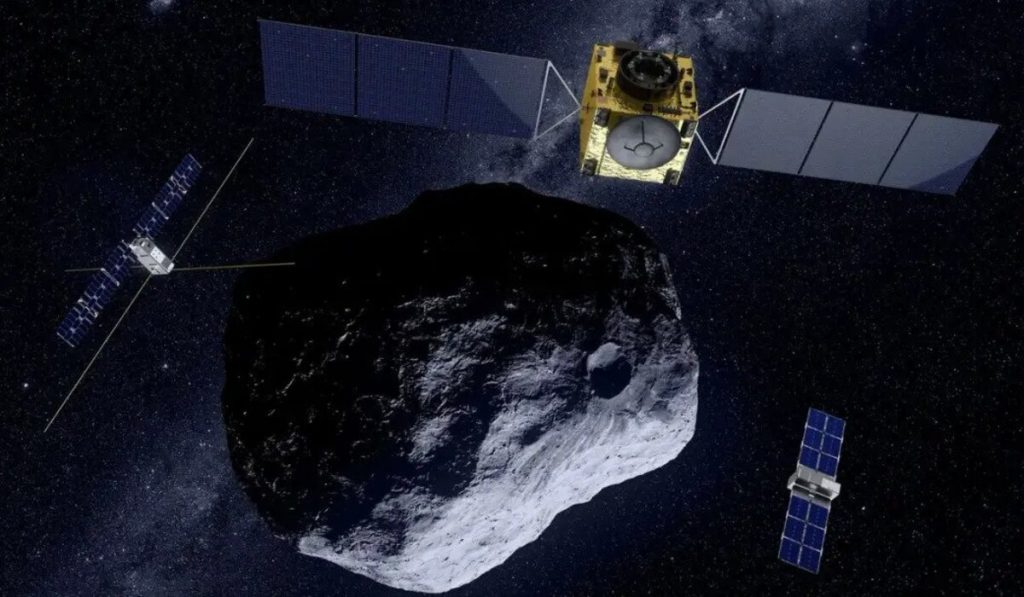The European Space Agency’s (ESA) Hera mission team recently obtained a glimpse of the rocky surface of Dimorphos, a small moon orbiting the colossal asteroid Didymos. Images captured by NASA’s DART mission, which successfully altered Dimorphos’ orbit through impact, have provided valuable insights for Hera’s upcoming CubeSat landings.
The presence of massive boulders on Dimorphos suggests that its formation may have involved the rapid ejection of material from its parent asteroid, Didymos, which has a shape resembling a spinning top. Naomi, a member of the mission team, emphasized the challenges of traversing this rugged terrain.
“The boulders covering the surface of Dimorphos are much bigger than they might look,” revealed Naomi Murdoch, a planetary scientist at ISAE-Supaero, France. Some of these rocks reach sizes as large as houses, measuring around 5-7 meters across.
She cautioned that moving across the boulders would require more climbing and jumping than walking, as excessive jumping could result in exceeding the escape velocity and being lost in space.
Navigating the low-gravity environment poses a risk of triggering rock avalanches due to significant ground motion. Patrick Michel, Hera’s Principal Investigator, highlighted the significance of Dimorphos’ surface properties in determining the behavior of landing astronauts.
“A lot depends on whether its material is hard or soft, which would determine how high an astronaut might bounce, or else sink,” explained Michel.
He drew parallels to NASA’s OSIRIS-REx mission, emphasizing the potential for astronauts to sink upon impact on a hard surface. Even a slight upward motion could propel them into orbit.
Dimorphos, approximately the size of the Great Pyramid of Giza, orbits the massive Didymos asteroid. DART’s impact successfully shifted Dimorphos’ orbit and released an estimated 1,000 tonnes of debris. The Hera mission, scheduled for October 2024, aims to gather close-up data on Dimorphos, including the size of the impact crater and the asteroid’s mineral composition.
Hera will deploy two CubeSats, Juventas and Milani, to explore Dimorphos. Juventas will probe the asteroid’s interior and measure its gravity field, while Milani will conduct mineral prospecting using a hyperspectral imager. Careful control of the CubeSats’ release velocity is crucial to prevent them from escaping the feeble gravity of the asteroid, as experienced with Japan’s Hayabusa mission in 2005 when the MINERVA lander was lost due to deployment in the wrong direction.
To glide over the surface, human astronauts will employ spikes, crampons, and thruster units, akin to scuba divers navigating a coral reef. Naomi warned of potential dangers, such as sharp rocks that could damage spacesuits. She explained that tidal forces from the parent asteroid Didymos cause a shift in weight by 10-20% depending on the surface location, further complicating movement.
Naomi warned about the potential dangers while gliding over the surface, cautioning against contact with sharp rocks that could snag spacesuits. “Your weight would shift by about 10-20% depending on where you are on the surface, because of tidal forces from the Didymos parent asteroid,” she explained.
Additionally, Dimorphos’ ever-changing rotation around Didymos introduces the risk of disorientation for astronauts.
Juventas and Milani will primarily maneuver around Dimorphos using cold gas thrusters before landing on the asteroid’s surface. These CubeSats possess instruments that can collect data independently of their orientation upon landing, providing valuable insights into Dimorphos’ weak gravity field.
As the Hera mission focuses on Didymos and Dimorphos, scientists eagerly anticipate the inter-satellite link transmissions, offering a glimpse into the rocky expanse of the cosmos that future human explorers may encounter.

